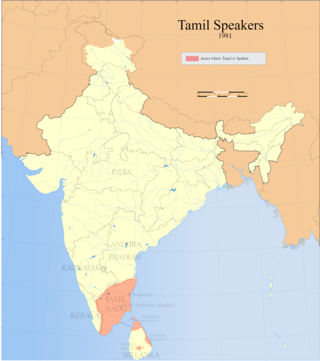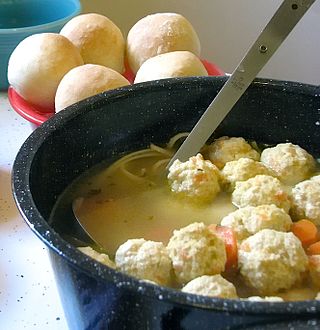
An omelette is a dish made from eggs, fried with butter or oil in a frying pan. It is a common practice for an omelette to include fillings such as chives, vegetables, mushrooms, meat, cheese, onions or some combination of the above. Whole eggs or egg whites are often beaten with a small amount of milk, cream, or water.

Malay cuisine is the traditional food of the ethnic Malays of Southeast Asia, residing in modern-day Malaysia, Indonesia, Singapore, Brunei, Southern Thailand and the Philippines as well as Cocos Islands, Christmas Island, Sri Lanka and South Africa.

Fried rice is a dish of cooked rice that has been stir-fried in a wok or a frying pan and is usually mixed with other ingredients such as eggs, vegetables, seafood, or meat. It is often eaten by itself or as an accompaniment to another dish. Fried rice is a popular component of East Asian, Southeast Asian and certain South Asian cuisines, as well as a staple national dish of Indonesia. As a homemade dish, fried rice is typically made with ingredients left over from other dishes, leading to countless variations. Fried rice first developed during the Sui dynasty in China.

Trinidad and Tobago has a unique history and its food is influenced by Indian-South Asian, West African, Creole, European, American, Chinese, Amerindian, and Latin American culinary styles. Trinidadian and Tobagonian food is dominated by a wide selection of dishes, most notably, doubles, roti, pelau, callaloo and curried crab and dumplings. Trinidad and Tobago is also known for its prepared provisions, such as dasheen, sweet potato, eddoes, cassava, yam, soups and stews, also known as blue food across the country. Corresponding to the Blue Food Day event held annually in Trinidad and Tobago.

Salvadoran cuisine is a style of cooking derived from the nation of El Salvador. The indigenous foods consist of a mix of Amerindian cuisine from groups such as the Lenca, Pipil, Maya Poqomam, Maya Chʼortiʼ, Alaguilac and Cacaopera peoples and some African influences. Many of the dishes are made with maize (corn). There is also heavy use of pork and seafood. European ingredients were incorporated after the Spanish conquest.

Tamil cuisine is a culinary style of Tamil people originating in the southern Indian state of Tamil Nadu and neighboring Sri Lanka. Meats, along with rice, legumes, and lentils, are popular. Dairy products and tamarind are used to provide sour flavors. On special occasions, traditional Tamil dishes are served in a traditional manner, using banana leaves in place of utensils. After eating, the banana leaves are then used as a secondary food for cattle. A typical breakfast meal consists of idli or dosa with chutney. Lunch includes rice, sambar, curd, kuzhambu, and rasam.

Singaporean cuisine is derived from several ethnic groups in Singapore and has developed through centuries of political, economic, and social changes in the cosmopolitan city-state.

Noodle soup refers to a variety of soups with noodles and other ingredients served in a light broth. Noodle soup is a common dish across East Asia, Southeast Asia and the Himalayan states of South Asia. Various types of noodles are used, such as rice noodles, wheat noodles and egg noodles.

Peranakan cuisine or Nyonya cuisine comes from the Peranakans, descendants of early Chinese migrants who settled in Penang, Malacca, Singapore and Indonesia, inter-marrying with local Malays. In Baba Malay, a female Peranakan is known as a nonya, and a male Peranakan is known as a baba. The cuisine combines Chinese, Malay, Javanese, South Indian, and other influences.

Javanese cuisine is the cuisine of Javanese people, a major ethnic group in Indonesia, more precisely the province of Central Java, Yogyakarta and East Java.

A tomato omelette is a breakfast dish prepared mostly in Maharashtra, India. It is referred to as an omelette because of its visual appearance, but this is a misnomer, as it actually contains no egg product or by-product and is vegan. The main ingredient is chickpea flour or besan. Sometimes, it is also made with dosa batter, with a small quantity of besan only to provide binding, in which case it is classified as Uttapam.

A meatball is ground meat (mince) rolled into a ball, sometimes along with other ingredients, such as bread crumbs, minced onion, eggs, butter, and seasoning. Meatballs are cooked by frying, baking, steaming, or braising in sauce. There are many types of meatballs using different types of meats and spices. The term is sometimes extended to meatless versions based on legumes, vegetables, mushrooms, fish or other seafood.

Malaysian Indian cuisine, or the cooking of the ethnic Indian communities in Malaysia, consists of adaptations of authentic dishes from India, as well as original creations inspired by the diverse food culture of Malaysia. Because the vast majority of Malaysia's Indian community are of South Indian descent, and are mostly ethnic Tamils who are descendants of immigrants from a historical region which consists of the modern Indian state of Tamil Nadu and Sri Lanka's Northern Province, much of Malaysian Indian cuisine is predominantly South Indian inspired in character and taste. A typical Malaysian Indian dish is likely to be redolent with curry leaves, whole and powdered spice, and contains fresh coconut in various forms. Ghee is still widely used for cooking, although vegetable oils and refined palm oils are now commonplace in home kitchens. Before a meal it is customary to wash hands as cutlery is often not used while eating, with the exception of a serving spoon for each respective dish.

Sambal is an Indonesian chili sauce or paste, typically made from a mixture of a variety of chilli peppers with secondary ingredients such as shrimp paste, garlic, ginger, shallot, scallion, palm sugar, and lime juice. Sambal is an Indonesian loanword of Javanese origin. It originated from the culinary traditions of Indonesia and is also an integral part of the cuisines of Singapore, Malaysia, Brunei, and Sri Lanka. It has also spread through overseas Indonesian populations to the Netherlands and Suriname.

Acehnese cuisine is the cuisine of the Acehnese people of Aceh in Sumatra, Indonesia. This cuisine is popular and widely known in Indonesia. Arab, Persian, and Indian traders influenced food culture in Aceh although flavours have substantially changed their original forms. The spices combined in Acehnese cuisine are commonly found in Indian and Arab cuisine, such as ginger, pepper, coriander, cumin, cloves, cinnamon, cardamom, and fennel.

Indian Indonesian cuisine is characterized by the mixture of Indian cuisine with local Indonesian-style. This cuisine consists of adaptations of authentic dishes from India, as well as original creations inspired by the diverse food culture of Indonesia. Indian influence can be observed in Indonesia as early as the 4th century. Following the spread of Islam to Indonesia and trading, Muslim Indian as well as Arab influences made their way into Indonesian cuisine. Examples include Indian biryani, murtabak, curry and paratha that influenced Acehnese, Minangkabau, Malay, Palembangese, Betawi and Javanese cuisine.

Hoppel poppel is an egg casserole made with leftovers, a dish associated with frugal housewives.

















